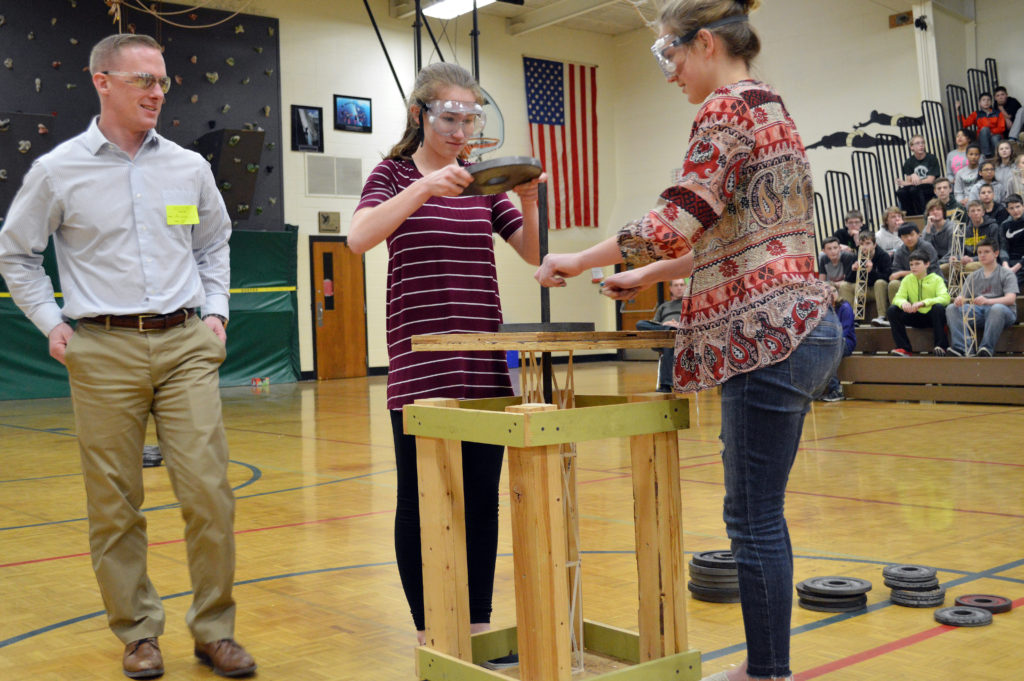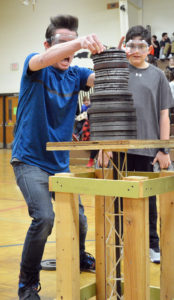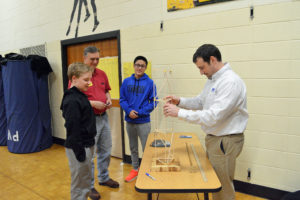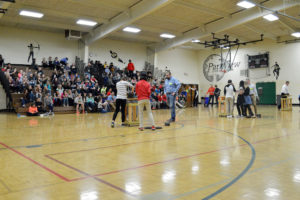Inspiring the Next Generation of STEM Graduates

Engineers make things work. As our world becomes increasingly dependent on innovation and technology, a deeper understanding of STEM (science, technology, engineering, and math) is becoming increasingly important. This evolution creates a gap between the marketplace demand for STEM graduates and those with the skills to fill those positions. (Learn more at STEM Village.)
How do we encourage the next generation of graduates to consider STEM courses and majors? By engaging students in a practical application of the critical, creative thinking exercised in STEM fields. One of those practical applications is the Tower Challenge.
What is the Tower Challenge?
 The Tower Challenge puts students in the role of a structural engineer. Their primary objective is to construct the strongest tower possible. To simulate actual job restrictions, students have limited materials to work with, and their structures must meet the design requirements set forth by the challenge. Participating students are provided with roughly 2 ounces of balsa wood and glue. The constructed towers must stand 2.5 feet tall with the end goal of supporting the students’ own body weight – or more.
The Tower Challenge puts students in the role of a structural engineer. Their primary objective is to construct the strongest tower possible. To simulate actual job restrictions, students have limited materials to work with, and their structures must meet the design requirements set forth by the challenge. Participating students are provided with roughly 2 ounces of balsa wood and glue. The constructed towers must stand 2.5 feet tall with the end goal of supporting the students’ own body weight – or more.
The excitement comes when the towers are put to the test, literally. To load test the structures, students insert a pole through the open center of each tower. A board is then placed on top of the towers, and students incrementally add barbell weights on top of the board. The total weight the tower holds before collapsing is recorded and divided by the tower’s weight to calculate the final weight ratio.
It’s Not the Material; It’s How You Engineer It That Counts
 The challenge is meant to encourage creative thinking, planning, and organization. The tower design and construction give practical application to the knowledge learned in math and science classes. Students also gain a deeper understanding of the engineering process.
The challenge is meant to encourage creative thinking, planning, and organization. The tower design and construction give practical application to the knowledge learned in math and science classes. Students also gain a deeper understanding of the engineering process.
After the kickoff meeting that introduces the project requirements, each student designs a tower using graphing paper. Then “project meetings” are held with engineering staff during the design and construction phases. After each individual design is approved, students are put into groups to perform the construction as a team. Engineers provide instruction on the importance of connections and bracing, discuss best practices, and answer questions.
The Competition
 At the final event, teams watch as the weight increases on their structures. Hushed voices predominate – punctuated by the occasional scream when each tower crashes under its load. Judges provide students with their towers’ ratio of strength and mass, which is used to identify the strongest tower.
At the final event, teams watch as the weight increases on their structures. Hushed voices predominate – punctuated by the occasional scream when each tower crashes under its load. Judges provide students with their towers’ ratio of strength and mass, which is used to identify the strongest tower.
Staff from our Green Bay office have been planning, coordinating, and volunteering for the annual Tower Challenge event for the past 20 years at Parkview Middle School in Ashwaubenon, Wisconsin, and just this year brought the Challenge to Luxemburg-Casco Middle School in Casco, Wisconsin.
We have judged more than a few towers over the years, and it never ceases to amaze the students how much their structures actually hold. At the 2017 Ashwaubenon Tower Challenge on March 3, the winning 2.25-ounce balsa tower held 200 pounds for a ratio of 88.9. Earlier that week at the Luxemburg-Casco Tower Challenge, one team’s tower held 280 pounds.
Witnessing the excitement this challenge brings is reinvigorating for our engineers and gives us optimism about the future of STEM industries.
Troy Robillard, PE, is a manager within our Midwest transportation operations. His areas of expertise include state and county highway design, construction administration, and urban street design. Troy has been involved with the Tower Challenge for 18 years.

 By
By
Post a comment: